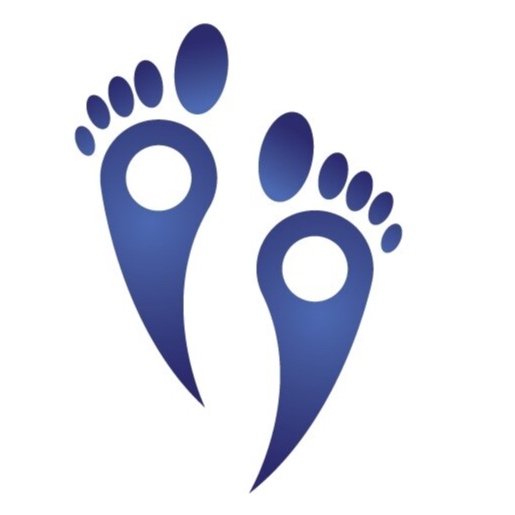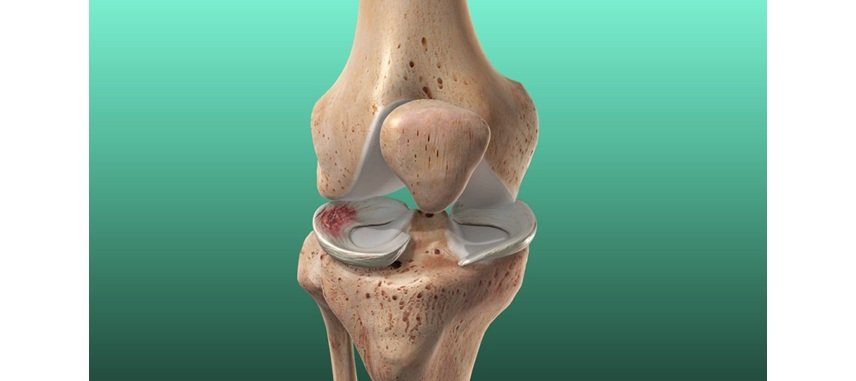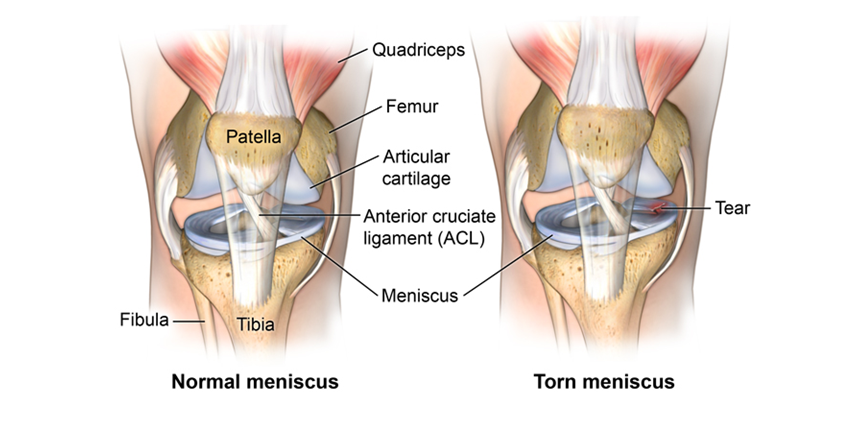Knee Meniscus Damage - Does it Heal on Its Own or Needs Treatment - Surgery or Physiotherapy & Injections
A meniscus tear, like many other knee problems, can be painful and debilitating. Regrettably, it is fairly prevalent.
Regardless of meniscal tear type, size or shape - It is hard to tell whether physiotherapy along with injections or meniscectomy (partial or full surgical shaving ) may work or may not work. Our clinicians perform thorough assessment and fully understands the situation before any call. However, this blog provides essential information in a very simplest possible way to understand the complexity of decision making around
Doing Nothing (Advice and Modifying Activities)
Doing Something (Physiotherapy and Injections as well as Advice and Modifying Activities)
Doing Surgery
So, what exactly is a meniscus?
It's a portion of cartilage that cushions and stabilises the joint in your knee. It shields the bones from deterioration. A decent twist of the knee, on the other hand, is all it takes to tear the meniscus. In certain situations, a piece of torn cartilage breaks off and gets caught in the knee joint that causes locking, clicking and catching. At times you feels knee giving way as your knee is going to collapse as you are walking.
Cause of Tear
Excessive or forceful twisting of the knee when the foot is placed on the ground is the most prevalent cause of a meniscus tear. This can happen as a result of a sloppy landing after a jump, or as a result of the force of another person's or opponent's body acting on the knee. If the stress is too high for the meniscus to handle during this type of movement, tears may occur. Injury to the medial (inside) meniscus is more common than to the lateral (outside) meniscus. Because the medial meniscus is attached to various structures within the knee joint, it is less movable to forces occurring on it than its anterior counterpart.
How Do I know If I damage my Meniscus - Symptoms and Signs
Depending on the source, the symptoms of a meniscal tear differ from person to person. A young footballer who has been injured after a high-force tackle will most likely present with a swollen and limited knee and be in a lot of pain. Injuries sustained in this manner are more likely to be severe, and ligament injuries are more likely to occur as well. An older individual who has spent the weekend gardening and spent a lot of time crouching and kneeling, on the other hand, may appear to the clinic with a quite different picture. There may not have been any high-force action involved; rather, the rip was caused by degenerative changes in the cartilage tissue.
How Do I know If I damage my Meniscus
⦁ Walking, squatting, or leaping causes pain.
⦁ Knee joint restriction, with or without swelling.
⦁ Locking of the knee joint - unable to straighten knee or unable to bend knee.
⦁ The sensation of popping or clicking (often following an episode of locking).
⦁ Fear that the knee will give way or collapse.
⦁ Tenderness along the plane of the torn ligament in the knee joint
National Institute of Clinical Excellence United Kingdom (NICE 2017)
How Do I know If I Damaged My Meniscus - Diagnosis
If you've damaged your knee, the first thing you should do is consult a physiotherapist or doctor as soon as possible. Following an event, a painful, swollen and inflamed knee is a warning that something is wrong, so get help straight away. We'll ask you questions about what happened and perform a thorough examination of your knee. The treatment for meniscal tears varies based on how the injury occurred (i.e., are we also dealing with a ligament damage? ), as well as the patient's age and goals.
National Institute of Clinical Excellence United Kingdom (NICE 2017) suggests if we suspect a substantial tear and a patient is experiencing significant pain, limitation, locking, and/or giving way in the joint, we may need to use imaging to determine the severity and further refer if needed .
Does a torn meniscus hurts all the time?
Yes, almost all meniscus tears will pain at some point. That isn't to say they won't hurt for a long time. Without surgery, the pain from a meniscus tear will often improve or disappear completely depending of above factors and following a correct rehabilitation plan through physiotherapist.
What happens If a meniscus tear is left untreated?
The frayed edge can become lodged in the joint, producing pain and swelling. It can also lead to long-term knee issues like arthritis and soft tissue damage.
Does a torn meniscus hurt at night?
Pain is the most prevalent symptom of a torn meniscus. At night, the discomfort can be excruciating. It usually improves over six weeks and is much improved at three months, however it may linger longer.
How can I speed up the healing of a torn meniscus?
⦁ The knee should be rested. If your knee hurts, limit your activities to walking.
⦁ To relieve discomfort and swelling, apply ice to your knee. Do this for 15-20 minutes every 3-4 hours for 2-3 days, or until the pain and swelling have subsided.
⦁ To reduce swelling, wrap your knee in an elastic bandage or a neoprene sleeve.
⦁ When sitting or lying down, elevate your knee by placing a pillow beneath your heel.
⦁ Anti-inflammatory drugs can be used; however, we advised to discuss with our prescribing therapist before taking them.
⦁ Stretching and strengthening activities might assist to relieve knee tension; however, needs to be performed under supervision of physiotherapist.
⦁ Running and jumping and high-impact exercises to avoid.
Rehabilitation will strive to achieve the following goals, regardless of the starting management:
⦁ Reduce knee discomfort and increase range of motion.
⦁ Quadriceps, hamstrings, calves, and other knee and hip-related muscles should all be strengthened.
⦁ Return to sport or former responsibilities as soon as possible to avoid additional injury.
Is walking good for torn meniscus?
The location and degree of the damage, as well as your own pain threshold, will determine whether you can walk on a torn meniscus. A minor tear might not bother you as much as you think. You might be able to walk reasonable distance and continue with activities of daily living with a torn meniscus in the knee.
What is the Best Treatment for Meniscus Damage - Do I Need To Surgery?
According to New England Journal of Medicine (2018) there is no significant difference between the two treatment options (physiotherapy and surgery) at 6 and 12 months as patient had some improvement in level of pain and knee function.
According to British Journal of Sports Medicine (2020) patients with symptoms of knee locking and clicking, bucket handle tears, and failed non-operative treatment such as physiotherapy and injections are candidates for arthroscopic meniscectomy (surgical shaving full or partial); however, on the other hand patients without symptoms of locking and more likely degenerative nature of tear are candidate for physiotherapy and injections. Results of this particular study supports the decision that conservative management (physiotherapy and injection) is appropriate as first-line therapy with symptomatic non-obstructive meniscal tears.
The location of the tear, what caused the tear, what sort of tear and how large it is, your symptoms, and finally your age and activity level will all assist you and your medical team decide if you need surgery to repair your meniscus tear. Let's have a look at these features in more detail.
How long does it take for a meniscus tear to heal?
If your meniscus tear is managed conservatively, without surgery, recovery will take about 6 months or more. The duration varies depending on the following factors:
Type and degree of the tear
Duration of your symptoms
Your lifestyle
Your age
1. What is the location of your tear?
The location of the meniscus tear will assist establish whether surgery is required. The outer third of the meniscus is the "red zone" with blood supply, whereas the inner third is the "blue zone" with no blood supply. The "white zone," which is devoid of blood circulation, is the inner two-thirds.
2. Did your tear occur as a result of trauma or degeneration?
A loaded deep knee bend or squat, as well as a pivot or twist, are the most common causes of meniscus injury. You frequently hear a pop and feel excruciating agony as it occurs. When a large number of micro injuries induce wear and tear over time, non-traumatic degenerative tears develop. Your symptoms, which include stiffness and discomfort, will gradually worsen.
3. What is the nature of your tear and how big is it?
Horizontal Tears: These tears are usually found in the white zone. Without surgery, they have a poor proclivity for healing. This form of tear, on the other hand, may typically be healed with a few stitches, saving your tissue.
Longitudinal Tears: These tears are usually partial, steady, and in the red zone. They rarely require surgery and may not even be visible on an MRI.
Radial Tears: The most prevalent sort of tears are radial tears. They're difficult to heal because they're in the white zone. This type of rip usually necessitates surgical intervention to remove the injured tissue and allow the body to recuperate.
Bucket Handle Tears: Large horizontal tears that fold over into the joint space are known as bucket handle tears.
Flap Tears: These are a less common type of tear. Transitioning from bending to straight positions may most likely cause a catching/snagging sensation. The capturing flap can usually be removed surgically with minimum tissue loss.
Degenerative Tears: These are caused by a series of micro-injuries that produce wear and tear over time. Your symptoms, which include stiffness and discomfort, will gradually worsen. Small tears may respond well following surgery, but bigger tears rarely do due to the amount of cartilage removed. The loss of cartilage, your body's natural cushion, might hasten the onset of arthritis in the place where it was removed.
4. What are the signs and symptoms you're experiencing?
Because the alteration in your anatomy has already created mechanical dysfunction in your knee, the likelihood of surgery is higher if you have mechanical symptoms. Keep an eye out for the following mechanical signs:
⦁ Audible and hearable pops or clicks during movement.
⦁ Locking, catching, instability, or buckling are all examples of locking, catching, instability, or buckling.
Conclusively:
According to British Journal of Sports Medicine (2020) patients with symptoms of knee locking and clicking, bucket handle tears, and failed non-operative treatment such as physiotherapy and injections are candidates for arthroscopic meniscectomy (surgical shaving full or partial); however, on the other hand patients without symptoms of locking and more likely degenerative nature of tear are candidate for physiotherapy and injections. Results of this particular study supports the decision that conservative management (physiotherapy and injection) is appropriate as first-line therapy with symptomatic non-obstructive meniscal tears as meniscectomy can result in development of progressive osteoarthritis.
We offer different types of injections for meniscus injury and tear following through assessment and examination.
Cortisone (steroid) injection
Hyaluronic (Ostenil Plus or Durolane)
Platelet Rich Plasma Protein (PRP)
To book for an appointment you can call our normal reception line, 0121 285 5656 or email direct to hello@thepodiatryclinics.co.uk requesting an appointment. Please include your name, date of birth, your address and GP contact details.
You will be sent a form to complete and forward back to us or bring along on the day.
References:
https://cks.nice.org.uk/topics/knee-pain-assessment/diagnosis/traumatic-causes/ National Institute of Clinical Excellence United Kingdom (NICE 2017).
Randomized Controlled Trial. N Engl J Med. 2013 May 2;368(18):1675-84. Surgery versus physical therapy for a meniscal tear and osteoarthritis. Jeffrey N Katz 1, Robert H Brophy, Christine E Chaisson, Leigh de Chaves, Brian J Cole, Diane L Dahm, Laurel A Donnell-Fink, Ali Guermazi, Amanda K Haas, Morgan H Jones, Bruce A Levy, Lisa A Mandl, Scott D Martin, Robert G Marx, Anthony Miniaci, Matthew J Matava, Joseph Palmisano, Emily K Reinke, Brian E Richardson, Benjamin N Rome, Clare E Safran-Norton, Debra J Skoniecki, Daniel H Solomon, Matthew V Smith, Kurt P Spindler, Michael J Stuart, John Wright, Rick W Wright, Elena Losina
Br J Sports Med. 2020 Mar;54(6):354-359. Can even experienced orthopaedic surgeons predict who will benefit from surgery when patients present with degenerative meniscal tears? A survey of 194 orthopaedic surgeons who made 3880 predictions. Victor A van de Graaf 1 2, Coen H Bloembergen MD 3 4, Nienke W Willigenburg PhD 3, Julia C A Noorduyn MSc 3, Daniel Bf Saris 2 5, Ian A Harris 6 7, Rudolf W Poolman 3, ESCAPE Research Group




